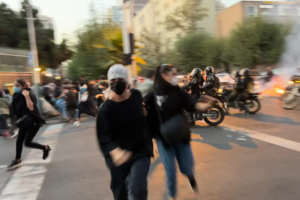How Women Are Leading the Protests in Iran
Protests erupted in more than 80 cities across Iran following the death of Mahsa Amini, known by her first Kurdish surname Jina, after her detention by the morality police under the so-called hijab law. Footage of the demonstrations posted to social media has become one of the primary windows into what is happening on the ground and revealed what is different about this latest show of resistance inside Iran.
The New York Times analyzed dozens of videos and spoke with experts who have followed the country’s protest movements to understand what insights the often blurry, pixelated footage contains about what is propelling the demonstrations.
Attacking Symbols of the State
Now in their third week, protests have continued even as dozens of people have been killed. Many of the videos appeared on social media during the first week of the protests, before Iran’s government began limiting internet access in an effort to silence dissent.
Multiple videos show a consistent theme of protesters attacking structures and symbols that represent Iran’s government, in some cases setting fire to municipal structures. In the northern city of Amol, demonstrators set fires in the complex of the governorate building, and elsewhere took down portraits of the supreme leader, Ayatollah Ali Khamenei, and the founding leader of the Islamic Republic, Ayatollah Ruhollah Khomeini.
Reza H. Akbari, a program manager for the Middle East and North Africa at the Institute for War and Peace Reporting, said that targeting state symbols is a response in part to the government’s failure to engage with civil society. Following a national uprising in 2009, the government weakened grass roots organizations, like labor unions and student groups, which were outlets for citizens to discuss their grievances and engage with policymakers. That segment of society, he said, “does not have that many options left than to resort to violent attacks on security and administrative buildings.”
He added that while the targeting of such buildings isn’t new, the widespread nature of the attacks is noteworthy.
Iran’s security forces have a history of using violence and brutality to suppress dissent. In many instances, authorities have shot protesters on the streets. Amnesty International has said that at least 52 people have been killed since the start of the protests, noting that the death toll is likely much higher. Videos capture men in military fatigues using Kalashnikov-type assault rifles in protest areas, as well as the sound of sustained bursts of automatic rifle fire breaking up crowds.
One of the latest examples surfaced online Friday, from protests in the southeastern city of Zahedan. Automatic rifle fire can be heard disrupting prayers at a nearby local mosque, and one video shows a number of apparently injured and bleeding men being tended to outside.
In the past, the families of those killed by security forces have been intimidated by the authorities into keeping quiet. But this latest round of protests has seen videos of funeral services uploaded online showing displays of public mourning, such as a woman cutting her hair over a coffin.
Narges Bajoghli, an assistant professor of Middle East Studies at Johns Hopkins University, noted how similar public mourning rituals for those killed in the 1979 Islamic Revolution were key to support for the revolution’s success. Now, spreading widely online, these scenes help boost antigovernment sentiment, she said.
“They’re grieving over their children being so senselessly murdered,” she said. “And that is now circulating online among Iranians. And so it creates even more grief, more rage but also more solidarity.”
Women in the Lead
Across Iran, videos show that women are most often at the forefront of the recent demonstrations, rallying crowds of both women and men by engaging in symbolic acts of defiance. One of these acts, women burning their hijabs, has become a dominant theme of the protests, representing both solidarity with Ms. Amini and pushback against the mandatory wearing of hijabs, one of the most visible symbols of the repression of women under the Islamic Republic.
The large number of women leading the protests “in so many of the videos that we see, we saw that in 2009, too,” said Dr. Bajoghli, referring to the 2009 uprising in Iran. “But here the numbers seem to be much greater.”
Mr. Akbari of the Institute for War and Peace Reporting, pointed to videos showing women cutting off their hair in public, or on social media, as unique to the current demonstrations. “It’s a very powerful gesture of Iranian women almost sarcastically and bitterly stating that: ‘If it’s the hair that is bothering you — if it’s the hair you want — here you go,’” he said.
Beyond the now viral clips of hijab burning and hair cutting, footage of the demonstrations also reveals new ways in which common protest language has become centered on women. Dr. Bajoghli noted the adaptation of a well-known chant, used in past protest movements, from “I will defend my brother” to “I will defend my sister.”
